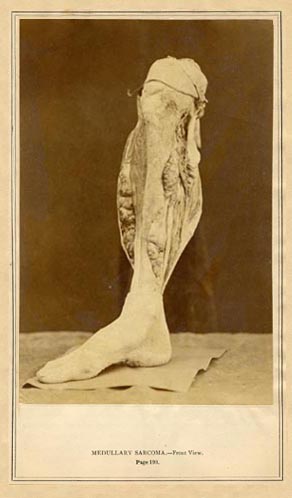

The Western Lancet.
Cole, R. Beverly, M.D., ed.
San Francisco: Cubery and Company, 1874[sic].
Vol. II., April, 1873., pp. 193-201.
Illustration: mounted albumens, on two sheets of heavy stock.
Subject: surgery, oncology.
21.5cm.
Quite likely a metastatic carcinoma of the tibia originating from a hypernephroma as the patient presented severe kidney pain and a urinary slough described as "little sacs of skin-like substance" which began five years before the first indication of the infection in the calf. Furthermore, Brigham describes the tumor as highly vascular, located in the metaphyses of both tibia and fibula and sheathed in a thin layer of connective tissue. Microscopy is less clear but Brigham observed:
... a disorderly collection of small ovoid and pyriform cells, having one or two prolongations from what seemed to be the body of the cell.
A reading of this report invokes an appreciation for the equanimity of mind with which men like Brigham advanced the general knowledge of neoplasms. In 1872 tumors were still classed by gross appearances. For example Paget, as Brigham notes in this report, classed medullary sarcomas as either hard (scirrhotic) or soft (encephaloid) and regarding the classification of this case, much of Brigham's discussion is over whether or not the infection was an aneurismal or pulsating tumor.
Even so, it is remarkable how much Brigham does get right and he hits all the important diagnostic criteria---both morphologic and statistic---such that his observations would be of value today.


